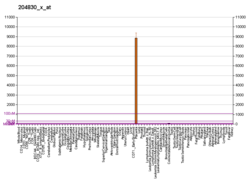Pregnancy-specific beta-1-glycoprotein 5 is a protein that in humans is encoded by the PSG5 gene.[3][4]
Further reading
- Panzetta-Dutari GM, Bocco JL, Reimund B, et al. (1993). "Nucleotide sequence of a pregnancy-specific beta 1 glycoprotein gene family member. Identification of a functional promoter region and several putative regulatory sequences". Mol. Biol. Rep. 16 (4): 255–62. doi:10.1007/BF00419665. PMID 1454058.
- Thompson J, Koumari R, Wagner K, et al. (1990). "The human pregnancy-specific glycoprotein genes are tightly linked on the long arm of chromosome 19 and are coordinately expressed". Biochem. Biophys. Res. Commun. 167 (2): 848–59. doi:10.1016/0006-291X(90)92103-7. PMID 1690992.
- Chan WY, Zheng QX, McMahon J, Tease LA (1991). "Characterization of new members of the pregnancy-specific beta 1-glycoprotein family". Mol. Cell. Biochem. 106 (2): 161–70. doi:10.1007/BF00230182. PMID 1922019.
- Thompson JA, Mauch EM, Chen FS, et al. (1989). "Analysis of the size of the carcinoembryonic antigen (CEA) gene family: isolation and sequencing of N-terminal domain exons". Biochem. Biophys. Res. Commun. 158 (3): 996–1004. doi:10.1016/0006-291X(89)92821-0. PMID 2537643.
- Oikawa S, Inuzuka C, Kuroki M, et al. (1989). "A pregnancy-specific beta 1-glycoprotein, a CEA gene family member, expressed in a human promyelocytic leukemia cell line, HL-60: structures of protein, mRNA and gene". Biochem. Biophys. Res. Commun. 163 (2): 1021–31. doi:10.1016/0006-291X(89)92324-3. PMID 2789512.
- Teglund S, Zhou GQ, Hammarström S (1995). "Characterization of cDNA encoding novel pregnancy-specific glycoprotein variants". Biochem. Biophys. Res. Commun. 211 (2): 656–64. doi:10.1006/bbrc.1995.1862. PMID 7794280.
- Olsen A, Teglund S, Nelson D, et al. (1995). "Gene organization of the pregnancy-specific glycoprotein region on human chromosome 19: assembly and analysis of a 700-kb cosmid contig spanning the region". Genomics. 23 (3): 659–68. doi:10.1006/geno.1994.1555. PMID 7851895.
- Strausberg RL, Feingold EA, Grouse LH, et al. (2003). "Generation and initial analysis of more than 15,000 full-length human and mouse cDNA sequences". Proc. Natl. Acad. Sci. U.S.A. 99 (26): 16899–903. doi:10.1073/pnas.242603899. PMC 139241. PMID 12477932.
- Colland F, Jacq X, Trouplin V, et al. (2004). "Functional Proteomics Mapping of a Human Signaling Pathway". Genome Res. 14 (7): 1324–32. doi:10.1101/gr.2334104. PMC 442148. PMID 15231748.
- Gerhard DS, Wagner L, Feingold EA, et al. (2004). "The Status, Quality, and Expansion of the NIH Full-Length cDNA Project: The Mammalian Gene Collection (MGC)". Genome Res. 14 (10B): 2121–7. doi:10.1101/gr.2596504. PMC 528928. PMID 15489334.
- Rual JF, Venkatesan K, Hao T, et al. (2005). "Towards a proteome-scale map of the human protein-protein interaction network". Nature. 437 (7062): 1173–8. doi:10.1038/nature04209. PMID 16189514.
- Blanchon L, Nores R, Gallot D, et al. (2006). "Activation of the human pregnancy-specific glycoprotein PSG-5 promoter by KLF4 and Sp1". Biochem. Biophys. Res. Commun. 343 (3): 745–53. doi:10.1016/j.bbrc.2006.03.032. PMID 16563348.
- Okazaki S, Sekizawa A, Purwosunu Y, et al. (2007). "Placenta-derived, cellular messenger RNA expression in the maternal blood of preeclamptic women". Obstetrics and gynecology. 110 (5): 1130–6. doi:10.1097/01.AOG.0000286761.11436.67. PMID 17978129.


